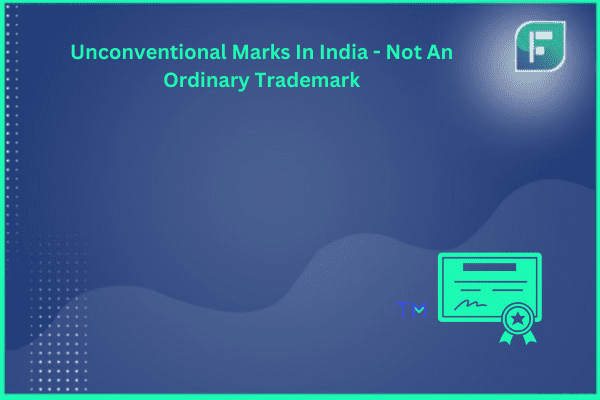The conventional elements in trademarks have been words, numerals, letters, logos or mixtures of them. These trademarks are the basis for identifying the source of services or goods and for establishing a brand’s identity and trust with customers. But as the marketplace gets to be more competitive by nature and brands search for brand new ways to distinguish themselves, unconventional trademarks have emerged as being a method.
These non-traditional marks go beyond photos and include textures, smells, and sounds as sense components. This article discusses the significance, legal framework, issues and outlook on unconventional trademark registration in India.
What Are Unconventional Trademarks?
Unconventional trademarks are marks which don’t belong to the traditional classes of visual symbols. They include non-visible and visible signs like sounds, smells, colors, forms of goods, motion/moving images, tastes, textures, and position marks.
These trademarks appeal to the senses to produce brand recognition through hearing, smell, and touch – forming memorable associations with customers. As an example, the distinct jingle of Intel or the scent of a luxury perfume might be powerful branding tools.
Different types of Unconventional Trademarks
These are the different kinds of unconventional trademarks available:
Sounds
Sound trademarks are distinct auditory components which identify the source of products or services. In India a sound mark might be visually represented by a series of musical notes followed by or without words and submitted in MP3 format not exceeding 30 secs. Examples of famous sound trademarks include the Intel jingle and the Nokia tune, which are recognizable worldwide.
Colors
Color trademarks identify the source of services or goods by specifying a color or color combination. While the Trademarks Act permits the registration of a mix of exclusive and contemporary colors, one color should have acquired secondary significance in connection with a service or product. Some examples are the purple Cadbury chocolate packaging and the red sole of Christian Louboutin shoes.
Smells
Less common, smell trademarks identify olfactory attributes of products or services. The registration of smell marks raises particular problems concerning their graphical representation and uniqueness. Examples from some other jurisdictions consist of freshly mown lawn for tennis balls and bubble-gum scent of shoes and sandals.
Shape of Goods/3D Marks
These trademarks consist of the shape of an item or its packaging. The shape of the goods and packaging might be registered as a Trademark subject to certain criteria of graphical representation and not of functionality. Some examples are the Coca-Cola bottle shape and also the Toblerone chocolate bar.
Motion/Multimedia
Motion trademarks contain moving components including movie clips or television show shifting logos. Together with sound they’re called multimedia marks. For example, the Columbia Pictures logo of a female holding a torch. The first motion trademark registered in India has been Nokia’s 2003 “Connecting Hands” animation.
Position
Position trademarks are marks which are placed in a particular way on an item. As an example, red on the sole of Christian Louboutin footwear. Such marks require a description of their position in the product.
Recommendations for Business for Unconventional Trademark Registration
Here are some useful recommendations for companies looking to register and protect unconventional trademarks in India:
- Documentation: Keep detailed records of the trademark’s connection and uniqueness with your services or products. This includes consumer surveys, market analysis and evidence of use in commerce.
- Legal Guidance: Seek legal advice on the registration process. Draft accurate definitions and representations of the mark may be provided by experienced trademark experts like StartupFino.
- Stay Informed: Learn about new developments in trademark law and trends in branding. This knowledge will be essential for adjusting to change and maximizing opportunities.
- Consumer Engagement: Engage consumers to foster associations and recognition for the unconventional trademark. Marketing campaigns and consistent use of the mark can help establish its uniqueness.
- International Strategy: Look at a worldwide trademark strategy in case your business is globally based. Know the trademark regulations in other jurisdictions so your mark has greater protection.
Conclusion
Unconventional trademarks represent an exciting and challenging frontier of branding. It gets increasingly important to safeguard these non-traditional marks as companies search for brand new means to reach consumers. The Indian legal structure continues to be changing but there are positive signs. Accepting change and learning from best practices around the globe can help India build a robust system for safeguarding unconventional trademarks.
The path towards complete recognition and protection of non-traditional marks continues. It involves collaboration between businesses, lawyers, policymakers and consumers. If given effort and adaptation, unconventional trademarks will get the protection they deserve and will feature centrally in modern branding strategies of Indian companies.
FAQs
Can smells and tastes be registered trademarks in India?
Smells and tastes are presently not considered trademarks in India due to problems such as need for graphical representation. No explicit prohibition prevails against the registration of smell or taste trademarks, but practical difficulties in representing these sensory experiences are a hurdle.
What troubles occur while registering a sound trademark in India?
The registration of sound trademarks in India faces difficulties mainly associated with the requirement of graphical representation. Sound marks must be represented graphically with complex or even subjective musical notations. Also, proving uniqueness and association with a certain product or service creates challenges during registration.
Any successful color trademark examples in India?
Yes, there are successful color trademark protection cases in India. Examples include the purple Cadbury’s chocolate packaging and also the red Colgate toothpaste packaging.
What are the limits for protecting unconventional trademarks in India?
The need for graphical representation is the principal restriction on safeguarding unconventional trademarks in India. Non-traditional trademarks including smells, motion marks and tastes have trouble meeting this criterion and thus lack registrability. Furthermore, association and uniqueness with a certain service or product could be hard to establish.






